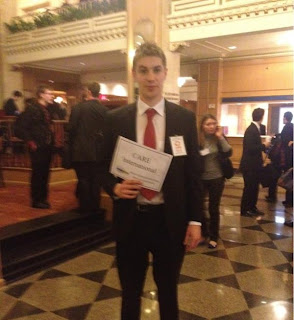HNMUN 2012: Incredible experience with a great crew of UCD students.
Was delighted to be a part of the 58th annual HNMUN session last February. The conference, staffed entirely by Harvard College graduates, took place in the historic Boston Plaza Hotel and was comprised of over 3,000 students from Colleges and Universities around the world! The objective of the conference is to simulate the activities of the UN but most importantly to gain a deeper understanding and appreciation of international negotiation.
My role within the conference was that of an NGO delegate. I represented CARE International, one of the worlds leading aid agencies dedicated to making long lasting, sustainable changes in poor communities. A lot of CARE's work focuses on working alongside women in developing countries as CARE believes given the right tools and support women in poor communities hold the key to ending poverty. The rest of my team represented the Burundi delegation.
The NGO delegate's role is unique in that it offers the opportunity to explore a variety of committees in the general assembly as oppose to other delegates representing countries who are assigned to committees. This meant I was able to explore around on the first day of the conference and eventually pick what committee suited CARE internationals work best and where I could best apply CARE internationals perspective. As an NGO representative beyond knowing just what the issues are at hand your expected to provide in-depth solutions and programs for addressing the issues.
Eventually I chose the UN Human Rights Council that was dealing with the Topic of "Third generation Human Rights," a big part of which was Women's rights in developing countries. A number of inequalities were discussed and highlighted such as:
- 70% of the 1.3 billion people in poverty are women. This derives from their unequal situation in the labour market, their treatment under social welfare systems and their status, and power in the family.
- A higher rate of unemployment among women than men is recorded in all regions of the world.
- The average female wage is only three-fourths of the male wage recorded in 55 countries that have comparable data.
- Women tend to occupy only 10% of parliamentary seats and only 6% of cabinet positions.
- Women work longer hours than men in nearly every country – 53% more hours than men in developing countries and 51% more in industrial countries.
As an NGO I had to deliver an introductory statement in front of the entire committee! I outlined the impact and scale of CARE internationals work, how the organisation is funded, biggest challenges we faced and finished with how specifically I can add some value to the committee's discussions by applying example case's of Care internationals work and the results it has achieved. I had to adapt to keep it relevant but luckily there was a programme CARE run's I had researched called "pathway to empowerment," which touched on all the relevant points and issues that the committee were discussing in relation to women's rights. The programme actually turned out to be a perfect fit and ended up being included the committee's draft resolution with a specific mention of CARE international. The programme was based around going to the root sources of women inequalities in developing countries and set out development pillars including:
- Increase the number of girls completing primary school through equitable, quality education; better transitions between grade levels; learning opportunities for older girls; supportive households and communities; and gender sensitive education policies.
- Build girls’ leadership skills through diverse extracurricular activities; new social networks; empowering relationships with educators, families and peers; and participation in voluntary civic action.
- Advocate for the rights of girls by addressing harmful traditional practices, reducing risk and vulnerability, and identifying role models and champions for girls.
All in all it was a great experience and I'd be lying if I didn't say there was some ridiculous partying done during the week also! Hope to return to HNMUN next year for 2013.
.jpg) |
| Team Burundi (4th from the left) |


.jpg)




